Mary Cronk Farrell's Blog, page 20
September 17, 2013
Proof E-books Just Won't Cut It
 With apologies to my sister Joanne for not reading this two-volume encyclopedia set she gave me Christmas 1987. But really, do you think you will still be using your e-book twenty-six years from now? When back and neck aches led me to go ergonomic, the first place I turned was that trusty set of encyclopedias.
With apologies to my sister Joanne for not reading this two-volume encyclopedia set she gave me Christmas 1987. But really, do you think you will still be using your e-book twenty-six years from now? When back and neck aches led me to go ergonomic, the first place I turned was that trusty set of encyclopedias.  When your daughter's a sweet toddler, you never expect to one day see books like FROM HELL in her room. But then you don't picture her painting her walls bright orange either. At least she knows the value of a good old-fashioned book!
When your daughter's a sweet toddler, you never expect to one day see books like FROM HELL in her room. But then you don't picture her painting her walls bright orange either. At least she knows the value of a good old-fashioned book!  I can't be the only one with worn out roller shades that won't stay down when you close them. Okay, maybe I am the only one who would move this stack of books back and forth two times a day instead of taking a trip to the hardware store. But you can bet I'm not getting this kind of mileage out of an e-book.
I can't be the only one with worn out roller shades that won't stay down when you close them. Okay, maybe I am the only one who would move this stack of books back and forth two times a day instead of taking a trip to the hardware store. But you can bet I'm not getting this kind of mileage out of an e-book. Uncle. I admit it. The lamp doesn't need height. I'm running out of room for these damn piles of books. Besides, this gives me a chance to say, "Isn't that a handsome son I have?"
Uncle. I admit it. The lamp doesn't need height. I'm running out of room for these damn piles of books. Besides, this gives me a chance to say, "Isn't that a handsome son I have?"
Published on September 17, 2013 08:10
August 11, 2013
My Conference Haul
How I wished I could buy books by every speaker at SCBWI-LA last week! Alas, neither my suitcase, nor my bank account would allow it, but here's a rundown of the nonfiction books I came home with. 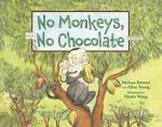 No Monkeys, No Chocolate by Melissa Stewart and Allen Young, illustrated by Nicole Wing shows the science of interdependence in nature in a kid-friendly way.
No Monkeys, No Chocolate by Melissa Stewart and Allen Young, illustrated by Nicole Wing shows the science of interdependence in nature in a kid-friendly way.
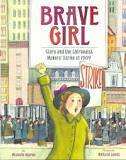 In Brave Girl: Clara and the Shirtwaist Makers' Strike of 1909, author Michelle Markel tackles the complex subject of labor unions by telling the story of one young garment worker's determination and courage. Melissa Sweets illustrations are wonderfully detailed.
In Brave Girl: Clara and the Shirtwaist Makers' Strike of 1909, author Michelle Markel tackles the complex subject of labor unions by telling the story of one young garment worker's determination and courage. Melissa Sweets illustrations are wonderfully detailed.
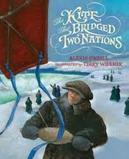 Lots of action and drama in The Kite that Bridged Two Nations by Alexis O'Neill, illustrated by Terry Widener, the story of a boy and his dream to fly his kite across the Niagara River.
Lots of action and drama in The Kite that Bridged Two Nations by Alexis O'Neill, illustrated by Terry Widener, the story of a boy and his dream to fly his kite across the Niagara River.
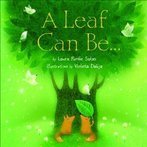 The combination of science and art, including vibrant illustrations by Violeta Dajija and spare lyrical poetry by Laura Purdie Salas, make A Leaf Can Be a feast for the senses.
The combination of science and art, including vibrant illustrations by Violeta Dajija and spare lyrical poetry by Laura Purdie Salas, make A Leaf Can Be a feast for the senses.  The story of Me and Momma and Big John is based on one of America first woman stonecutters. Author Mara Rockliff and illustrator William Low's combined talents explore the grace and dignity of a craftperson's work even if it never brings fame or fortune.
The story of Me and Momma and Big John is based on one of America first woman stonecutters. Author Mara Rockliff and illustrator William Low's combined talents explore the grace and dignity of a craftperson's work even if it never brings fame or fortune.
The nonfiction picture books available for kids today are quality works of art. Text and illustration work together to tell multi-leveled stories that will resonate with young and old alike.
Do chime in with your thoughts on these or other amazing new nonfiction picture books.
 No Monkeys, No Chocolate by Melissa Stewart and Allen Young, illustrated by Nicole Wing shows the science of interdependence in nature in a kid-friendly way.
No Monkeys, No Chocolate by Melissa Stewart and Allen Young, illustrated by Nicole Wing shows the science of interdependence in nature in a kid-friendly way.
 In Brave Girl: Clara and the Shirtwaist Makers' Strike of 1909, author Michelle Markel tackles the complex subject of labor unions by telling the story of one young garment worker's determination and courage. Melissa Sweets illustrations are wonderfully detailed.
In Brave Girl: Clara and the Shirtwaist Makers' Strike of 1909, author Michelle Markel tackles the complex subject of labor unions by telling the story of one young garment worker's determination and courage. Melissa Sweets illustrations are wonderfully detailed.
 Lots of action and drama in The Kite that Bridged Two Nations by Alexis O'Neill, illustrated by Terry Widener, the story of a boy and his dream to fly his kite across the Niagara River.
Lots of action and drama in The Kite that Bridged Two Nations by Alexis O'Neill, illustrated by Terry Widener, the story of a boy and his dream to fly his kite across the Niagara River.
 The combination of science and art, including vibrant illustrations by Violeta Dajija and spare lyrical poetry by Laura Purdie Salas, make A Leaf Can Be a feast for the senses.
The combination of science and art, including vibrant illustrations by Violeta Dajija and spare lyrical poetry by Laura Purdie Salas, make A Leaf Can Be a feast for the senses.  The story of Me and Momma and Big John is based on one of America first woman stonecutters. Author Mara Rockliff and illustrator William Low's combined talents explore the grace and dignity of a craftperson's work even if it never brings fame or fortune.
The story of Me and Momma and Big John is based on one of America first woman stonecutters. Author Mara Rockliff and illustrator William Low's combined talents explore the grace and dignity of a craftperson's work even if it never brings fame or fortune.The nonfiction picture books available for kids today are quality works of art. Text and illustration work together to tell multi-leveled stories that will resonate with young and old alike.
Do chime in with your thoughts on these or other amazing new nonfiction picture books.
Published on August 11, 2013 17:54
July 18, 2013
Chocolate Tomatoes & How We Rarely Enjoy Opposing Realities
 Sweet One-hundred, Sun Sugar and Chocolate Cherry tomatoes It’s rare you can eat chocolate and simultaneously get a serving of fruit/vegetables. However, these brownish-purple tomatoes live up to their name Chocolate Cherry.
Sweet One-hundred, Sun Sugar and Chocolate Cherry tomatoes It’s rare you can eat chocolate and simultaneously get a serving of fruit/vegetables. However, these brownish-purple tomatoes live up to their name Chocolate Cherry.My mouth watered as I picked them, but I had nagging unease. The pansies bordering my little garden needed deadheading. I’d already spent ten minutes picking the lettuce and another ten minutes picking the raspberries. My precious early morning was slipping away and I wanted to be at my computer writing. I also wanted to be relaxing on my porch with a cup of coffee.
Feeling my unease, I paused. Let the realization sink in. I couldn’t enjoy all of these things at the same time, and I didn’t need to harken back to high school economics to understand opportunity cost. Part of accepting adulthood is understanding we have to make tough choices.
When we don’t choose–when we try to enjoy two opposing realities–we’re never at ease. We’re stressed. We complain. We make ourselves miserable, and I dare say those around us miserable, too.
Another example…getting frustrated because I expected my manuscript back from my editor last week and who knows when it’ll arrive? I made the choice to be a writer and to enter into a publishing agreement. At the time, I knew publishing can be agonizingly slow. I knew I wouldn’t have control over the schedule as my book progressed through editing and design. I chose one and not the other. I can’t enjoy both. And as long as I don’t accept that, I won’t be at ease. I’ll be stressed. I’ll be miserable…you get the picture.
So I popped one those chocolates in my mouth and I remembered the choice I’d made to plant my garden and care for it. Did I want to change my mind now? I’m free to let the garden go and sit on my porch and drink coffee. Do I want to be a writer with a book coming out with a respected publisher? Or do I want to control over my schedule?
Everyday, these choices lie before us. Large and small. If we don’t look at the opportunity cost fair and square and choose the price we’re willing to pay–we’re choosing misery over happiness.
Do you think this is true? Or a bunch of bunk? I'd love to know what you think. Go ahead and leave a comment.
Published on July 18, 2013 09:23
June 6, 2013
Remembering D-Day
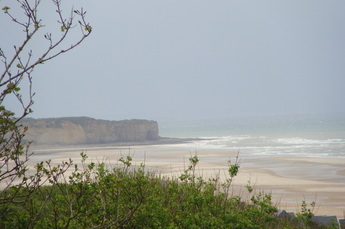 Gold Beach today. (Actually two weeks ago when I had the honor of walking on these sands). Gold Beach was the D-day code-name for where the British Forces landed on Normandy.
Gold Beach today. (Actually two weeks ago when I had the honor of walking on these sands). Gold Beach was the D-day code-name for where the British Forces landed on Normandy. After the initial invasion, the British constructed a temporary harbor on the coast at the town of Arromanches, so forces could more easily and quickly offload cargo to support the invading armies. Today you can see its remains, prefabricated sections taken across the English Channel from Britain and assembled here.
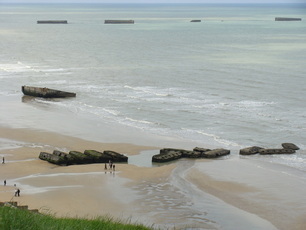 Mulberry Harbor at Arromanches
Mulberry Harbor at Arromanches
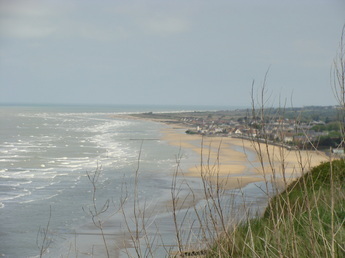 Omaha Beach where U.S. Forces landed on D-Day. My husband's father landed here one month after D-day, July 6, 1944. It's difficult and painful to imagine this peaceful shore was the site of a fierce battle and much bloodshed.
Omaha Beach where U.S. Forces landed on D-Day. My husband's father landed here one month after D-day, July 6, 1944. It's difficult and painful to imagine this peaceful shore was the site of a fierce battle and much bloodshed. While visiting Normandy, we discovered D-day is the latest in a string of bloody battles fought here throughout history, including Henry I of England's invasion of Normandy in 1106. A century earlier the Duke of Normandy set off from here to win the Battle of Hastings and become the King of England, and eventually become known as William the Conqueror.
 U.S. Cemetary near Omaha Beach where Americans who died at Normandy are remembered. If you are interested in World War II history, check back here. For five years, I've been working on a book about U.S. military women in the Pacific Theater of the war. I'll be sharing some stories very few people have heard.
U.S. Cemetary near Omaha Beach where Americans who died at Normandy are remembered. If you are interested in World War II history, check back here. For five years, I've been working on a book about U.S. military women in the Pacific Theater of the war. I'll be sharing some stories very few people have heard.My father-in-law was 19-years-old when he joined the battle in France. Do you have stories of relatives who fought in WWII? Please share them in the comments. Thank you.
Published on June 06, 2013 08:30
March 7, 2013
What's the Next Big Thing?
Authors talk
about their WIP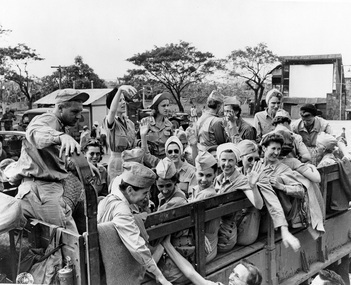 US Army Nurses Liberated from captivity in the Philippines, February 1945.
US Army Nurses Liberated from captivity in the Philippines, February 1945.
Thanks Author Meghan Nuttall Sayres for tagging me in the Next Big Thing Blog Hop!
What is the working title of your book?
Pure Grit: How American Military Nurses Survived War in the Pacific and Japanese Prison Camp
Where did the idea come from for the book?
My cousin wrote a paper for nursing school about these Army and Navy nurse POWs in WWII. She e-mailed me her paper and as soon as I read it I knew I had to write a book about these brave women.
What genre does your book fall under?
Pure Grit is non-fiction for teens.
What is the one-sentence synopsis of your book?
Pure Grit is the story of 79 U.S. nurses captured POW by the Japanese after the American surrender of Bataan and Corregidor in 1942.
Will your book be self-published or represented by an agency?
Pure Grit is represented by Stephen Fraser of the Jennifer DeChiara Literary Agency and will be published by Abrams Books for Young People.
How long did it take you to write the first draft of your manuscript?
I wrote the first draft in a little over two months, but this was after I had written in-depth proposal which also took at least two months, before which I had been researching this story off and on for several years.
What other books would you compare this story to within your genre?
Pure Grit is sort of a combination of Almost Astronauts: 13 Women Who Dared to Dream by Tonya Lee Stone and The Greatest Generation by Tom Brokaw.
Who or what inspired you to write this book?
I have been deeply inspired by the Army and Navy nurses I wrote about in Pure Grit. These women learned combat nursing under fire when the Japanese attacked the Philippines shortly after bombing Pearl Harbor, Hawaii. They treated thousands of wounded and dying soldiers in jerry-rigged jungle hospitals. When forced to surrender they stuck together and continued to nurse the sick and dying. The courage and strength of these women kept them alive through three years’ isolation, disease, and starvation. They are true American heroines and I’m so proud to be able to tell their story.
What else about your book might pique the reader's interest?
Romance! Though Pure Grit is a story of war and prison camp, it is also a story of the triumph of the human spirit and the power of love.
I'm tagging Author John Bladek--Check out his next big thing!
about their WIP
 US Army Nurses Liberated from captivity in the Philippines, February 1945.
US Army Nurses Liberated from captivity in the Philippines, February 1945. Thanks Author Meghan Nuttall Sayres for tagging me in the Next Big Thing Blog Hop!
What is the working title of your book?
Pure Grit: How American Military Nurses Survived War in the Pacific and Japanese Prison Camp
Where did the idea come from for the book?
My cousin wrote a paper for nursing school about these Army and Navy nurse POWs in WWII. She e-mailed me her paper and as soon as I read it I knew I had to write a book about these brave women.
What genre does your book fall under?
Pure Grit is non-fiction for teens.
What is the one-sentence synopsis of your book?
Pure Grit is the story of 79 U.S. nurses captured POW by the Japanese after the American surrender of Bataan and Corregidor in 1942.
Will your book be self-published or represented by an agency?
Pure Grit is represented by Stephen Fraser of the Jennifer DeChiara Literary Agency and will be published by Abrams Books for Young People.
How long did it take you to write the first draft of your manuscript?
I wrote the first draft in a little over two months, but this was after I had written in-depth proposal which also took at least two months, before which I had been researching this story off and on for several years.
What other books would you compare this story to within your genre?
Pure Grit is sort of a combination of Almost Astronauts: 13 Women Who Dared to Dream by Tonya Lee Stone and The Greatest Generation by Tom Brokaw.
Who or what inspired you to write this book?
I have been deeply inspired by the Army and Navy nurses I wrote about in Pure Grit. These women learned combat nursing under fire when the Japanese attacked the Philippines shortly after bombing Pearl Harbor, Hawaii. They treated thousands of wounded and dying soldiers in jerry-rigged jungle hospitals. When forced to surrender they stuck together and continued to nurse the sick and dying. The courage and strength of these women kept them alive through three years’ isolation, disease, and starvation. They are true American heroines and I’m so proud to be able to tell their story.
What else about your book might pique the reader's interest?
Romance! Though Pure Grit is a story of war and prison camp, it is also a story of the triumph of the human spirit and the power of love.
I'm tagging Author John Bladek--Check out his next big thing!
Published on March 07, 2013 15:45
March 5, 2013
Next Big Thing Blog Hop Coming Up...
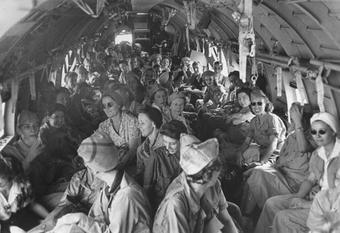 My Next Big Thing is a story about this photo. More to come...
My Next Big Thing is a story about this photo. More to come...
Published on March 05, 2013 21:45
January 2, 2013
Get Your Subconscious on Your Side
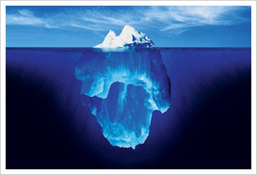 Look to proven psychology to help you stick to your writing/ illustration goals in 2013.
Look to proven psychology to help you stick to your writing/ illustration goals in 2013.Breaking old habits and building new ones is difficult because we pit our will power against our subconscious mind. That’s like trying to hit a bulls eye by throwing darts faster and harder while the target is in another room.
Habits live in the subconscious, which helps us brew coffee in the morning while still half asleep. When we’re walking along dreaming of making the New York Times Bestseller List, it’s the subconscious that turns our eyes both directions before we step off the curb. This mechanism makes habits hard to break.
One simple technique can help. When trying to break old habits and make better ones, the key is identifying the triggers that prompt the subconscious into action. For instance, what is getting in the way of your writing time? The dirty dishes in the sink? Fear of failure? A need for excitement? Discover what triggers your bad habit and you’re on the way to changing it.
Form an if-then statement linking the trigger to your old habit with your new goal. Something like, when I see the dirty dishes, I will go straight to the computer and write. Or, when I feel the need for excitement, I will turn that energy into drafting juicy conflicts for my characters. Each time you follow the trigger to your new goal, it strengthens a new neuro-pathway in your subconscious mind.
It take time for the old path to give way to the new, so don’t be hard on yourself when you fall into your old unconscious habits. Accept that the old habit is strong and do not resist it. Research shows, what you resist, persists. Fighting the old habit with will power, actually strengthens it.
Don’t fight nature. Work with your subconscious mind. In 2013, I am working on identifying what triggers my self-critic into revving up. What about you? Do you dare take a peek under the waters of your subconscious?
Thanks to lavanyashukla.com for the image today.
Published on January 02, 2013 14:14
November 18, 2012
Let Fear Reveal Strength
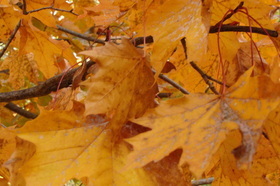 The falling leaves outside my window are ripe with metaphor for the creative life. As the tree lets go its leaves to go dormant and prepare for spring growth, a writer must let go of many things for her work to leave the dormant stage and flower in the light of day.
The falling leaves outside my window are ripe with metaphor for the creative life. As the tree lets go its leaves to go dormant and prepare for spring growth, a writer must let go of many things for her work to leave the dormant stage and flower in the light of day. Fear is one thing I must let go over and over again.
“Face your fear!” I heard this advice a lot, but I had absolutely no idea how to do that. My fear paralyzed me every time I sat down at the keyboard. I couldn’t sit and face it– I had to produce. I had to get words on the page. So for many years I ignored fear. I resisted fear. I buried fear under a huge pile of leaves in the backyard of my brain. I wanted to get rid of it for once and for all.
One writing book suggested I whisper “shhh” whenever I felt fear. My fear was not like a crying baby. My fear was like a hurricane. I needed a stronger weapon than shhh.
Another writing book suggested taking off all my clothes and writing naked. I did it. That’s how desperate I was to be free of my fear.
Finally, I realized my fear is not some alien force out there waiting to pounce. Fear is embedded deep in the cells of my blood and my bones. Fear kept my ancestors alive. Denying, hiding, ignoring fear is akin to denying, hiding, ignoring my hazel eyes or my love or words.
It’s impossible to lop off a basic part of oneself and try to move on in a creative endeavor. Often we think we can create just by using our brains. Writing, illustration, cooking, juggling or whatever your creative work happens to be–requires whole-hearted attention.
Being whole-hearted means laying down our weapons. Instead of fighting parts of ourselves, it’s more helpful to accept what is.
Invite fear in. See it. Feel it. Know it for what it is. A single leaf, one of many we can let go. All the better to reveal the strength of the trunk and branches.
What strategy helps you deal with fear?
Published on November 18, 2012 19:46
July 17, 2012
Boredom is just a stage
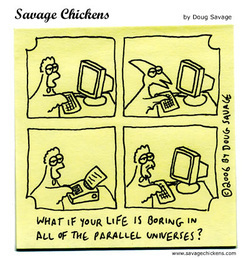 Yesterday, I read a blog about boredom being part of the creative process.
Yesterday, I read a blog about boredom being part of the creative process. This so describes me. When I am trying to grind out the first draft of something, I sit in front of the screen and feel BORED. I hadn’t seen this before. I had sometimes labeled it fear. At times it definitely was fear. A lot of the time it was fear.
Over the years I have come to peace with the fear. I had not previous recognized the boredom except to the extent that what I was trying to write seemed terribly boring. How could I write something that others would want to read, if it was boring me? I saw this as a weakness on my part. It’s is hard to accept weakness and not feel badly about it. It’s hard to write anything of value when I am feeling badly about myself. You can see were this spiral is leading.
Today when I sat down to write, my first reaction was boredom. Seeing it as part of the creative process tells me it’s not a problem, tells me I will move through it just as I move through all stages of the creative process. Makes a huge difference.
Does boredom figure in your creative process? How have you dealt with it?
Thanks for the cartoon! www.savagechickens.com
Published on July 17, 2012 09:56
July 11, 2012
Why Writers Need a Green Thumb
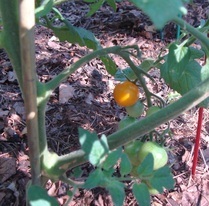 Ate my first tomato from the garden!
Ate my first tomato from the garden! I know, can you believe how tiny it is?
I love digging in the dirt and planting seeds. I go crazy at the nursery over the colorful pansies and begonias. And I feel great satisfaction transplanting tomatoes from the local greenhouse and seeing fresh, green shoots come up.
But we usually have a long, cool June here, and waiting for everything to grow, I grow impatient. Definite parallels exist between gardening and the writing life.
Same time I planted my garden, I polished a draft of my next book. When the pub date shifted from fall of 2013 to spring of 2014, my impatience...well, it had a growth spurt.
“I’ll probably be dead by then!” I wanted to scream at my editor.
But my tiny and fragile basil seedlings sat under a grow light next to my desk. I couldn’t raise my voice in their presence.
Gardening requires diligent work: preparing the earth, planting seeds, watering and fertilizing. But there’s a point where the gardener must let go and wait. No amount of effort will make the plants grow, bloom and produce. Same with a book. Once it’s been written and sent off to the publisher, it’s out of my hands.
In the next month I’ll go out to my garden, pull a few weeds, stake a few vines, pinch off extraneous shoots. But I recognize a lot depends on the weather, whether the bees come round and pollinate, and the pests and diseases that threaten my crops.
With a book, there’s always more a writer can do in terms of promotion, but you can’t force a publisher to publish it, and you can’t force people to buy it, anymore than a gardener can force a tomato to ripen.
This season I’m bringing my green thumb inside to my writing desk. I’m letting go of the anxiety, and the mistaken notion of control. I’m choosing to trust that my hard work and attention to the details of the craft will flower and fruit.
Meanwhile, I’ll enjoy the lettuce.
What do you do to carry your excitement through while waiting...and waiting...and waiting?
Published on July 11, 2012 22:50



